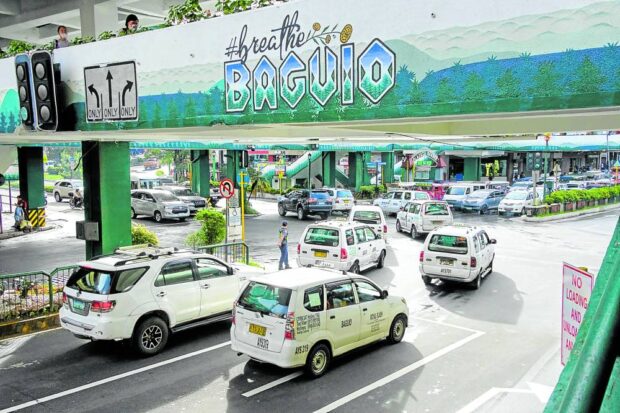Baguio eyes ‘congestion fee’ for visitors

BAGUIO (TRAFFIC) JAM The summer capital may not have the same volume of congestion suffered in Metro Manila but gridlocks, particularly during weekends, as shown in this photo taken on Sept. 6 in downtown Baguio, have been the subject of complaints from both residents and visitors. —NEIL CLARK ONGCHANGCO
BAGUIO CITY — To manage unbearable traffic in the city, particularly during weekends and holidays, tourists and businessmen who frequently drive up to the summer capital may end up paying a “congestion fee,” according to the local traffic czar.
Januario Borillo, who heads the Traffic and Transportation Management Division of the City Engineering Office, told the city council on Monday that the fee would help finance future road management projects, including the possibility of offering free rides in electric-powered public transport vehicles to residents and tourists.
Borillo said the crippling traffic jams occurred every day, particularly around downtown Session Road.
Last year, the city council discussed a P50 fee to be collected from out-of-town motorists at the city’s borders but the councilors have yet to reach a decision on the matter. But the proposal has the support of Mayor Benjamin Magalong who, in August of that same year, said a congestion fee could be part of a low-carbon smart mobility master plan his administration was developing.
Baguio’s smart mobility project incorporates plans for either an aerial cable car or a monorail coursing through downtown Baguio to reduce pollution and eliminate the need for driving from residential zones to the busy central business district. It also aims to employ automated traffic guiding systems and noncontact traffic enforcement mechanisms using artificial intelligence-aided street cameras.
Perfectly legalIn an April 14 legal opinion, Interior and Local Government Undersecretary Juan Victor Llamas told Magalong and the city government that they would not face “legal impediment in the adoption of a congestion pricing scheme,” citing Republic Act No. 7160 (the 1991 Local Government Code), the Constitution and relevant jurisprudence from the Supreme Court.
“It is understood that the proposed imposition of congestion fees by the city of Baguio is for the general welfare of its constituents and its visiting tourists, which is in accordance with Section 16 of RA 7160,” Llamas said, but noted that the fees must not be “unfair or oppressive.”
Borillo said how much Baguio would charge tourists was still being worked out.
When asked during the council’s session, he said the city’s smart mobility plan takes into account a 2019 carrying capacity report that described the century-old Baguio’s narrow roads as no longer sufficient for its current population of 366,358 (per the 2020 census) and a “daytime” population of over 700,000 when workers, traders, and students enter the city from neighboring towns.
The report commissioned by the National Economic and Development Authority (Neda) said the combined 349 kilometers of Baguio streets and local roads could only support 145,416 residents.
Last year, Borillo informed the council that as many as 50,000 to 60,000 people are on the road in Baguio at any given moment.
The Neda report was validated by a 2021 Asian transport paper written by City Planning and Development Officer Donna Tabangin Rimando, Saint Louis University engineering professor Mark de Guzman and the late University of the Philippines Diliman urban planning professor Candido Cabrido Jr., who proposed a “multimodal transport network” that links the operations of the traditional jeepney network with a centralized bus terminal, any type of monorail system and “aerial ropeway cable cars.” INQ